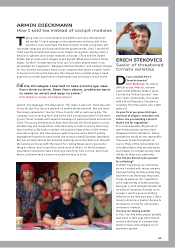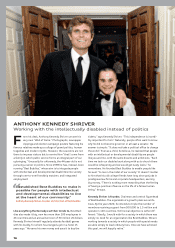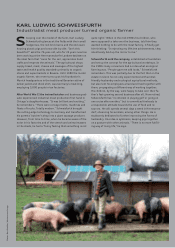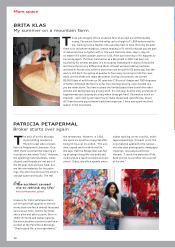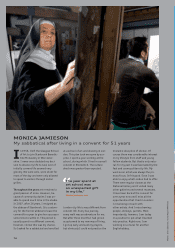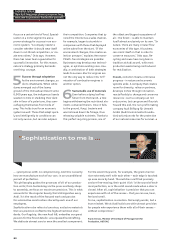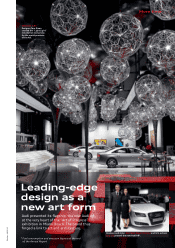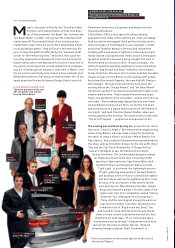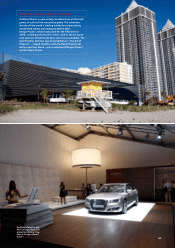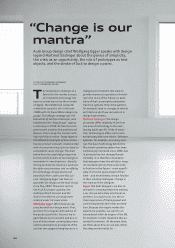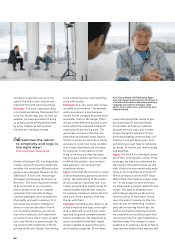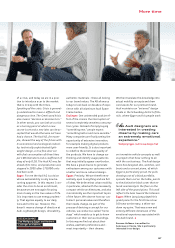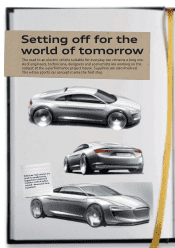Audi 2009 Annual Report Download - page 82
Download and view the complete annual report
Please find page 82 of the 2009 Audi annual report below. You can navigate through the pages in the report by either clicking on the pages listed below, or by using the keyword search tool below to find specific information within the annual report.
More time
79
COPY/ERICH SCHNEIDER
nature is the bird that cleans the skin
of hippos. Both sides profit, with the
bird receiving nourishment and the
hippo maintaining good hygiene. The
sum of this symbiosis is the production
of an ecosystem. Symbiosis can also
lead to success in economic systems
such as networks. This has been seen in
California’s flourishing Silicon Valley
(see page 94), a loose network of high-
tech companies. “On the one hand, the
companies compete with each other,
but on the other, they are also net-
worked through things like research
projects,” Herrmann-Pillath says. As in
nature, a healthy balance between
competition and cooperation deter-
mines the stability of an economic
system.
Courage to fill a niche
Evolution is the mother of
invention. “Plants and or-
ganisms continuously reinvent their
environments. In this way, they create
niches where they can grow,” Herr-
mann-Pillath says. Darwin’s finches are
a famous example of the development
of new niches. To survive on the barren
Galapagos Islands off the coast of
Ecuador, these songbirds divided
themselves into subspecies with differ-
ent eating habits. Each type of finch
has a different beak so that it can
Green offspring: These seedlings will grow
into robust oak trees.
The Environmental Foundation supervises
the reforestation of a forest near Ingolstadt.
the more effectively they can tackle a
challenge,” says Herrmann-Pillath. For
this reason, teams should consist of
experts with different cultural back-
grounds, specialty areas and personal-
ities. The experts exchange ideas in
a group and combine the individual
aspects of their proposed approaches
until they find the optimal solution.
Nature produces innovations according
to the same principle. If two organisms
crossbreed, parts of their chromo-
somes, and the chromosomes them-
selves, are reconfigured. Only the best
assimilated organisms survive – result-
ing in a continuous optimization
process.
Crisis as an opportunity
A crisis can occur in nature, just
as it does within an economic
system. “During an ice age, many
species die out; afterward, the rate
of development for new species sky-
rockets,” Otto says. Nature reacts to a
crisis with new construction plans, and
organisms develop innovative ways to
handle resources. Similarly, a crisis
both sends shockwaves through an
economic system and presents it with
opportunities. Those that adapt quickly
to changing conditions can also experi-
ence swift growth.
The potential in a crisis lies in its disor-
der. One example of this is seen in how
metals form crystals. “Heat causes the
structures to jumble together. New
arrangements are created from this
disarray during the cooling process,
and at some point, crystal is pro-
duced,” Herrmann-Pillath explains. In
an economic system, good things also
often emerge from disorder. A crisis
knocks markets out of their routines –
creating an opportunity to leave old
paths, seek new approaches and re-
shape the future.
Strength through partnership
Evolution means a merciless
fight for survival. But the idea
that only individual fighters are in-
volved is misguided. Often, the suc-
cessful organisms are those that enter
into partnerships. One example from
hen the Audi Environ-
mental Foundation was
established, the occasion
was marked by the planting of 36,000
oak trees northeast of Ingolstadt.
Storms and drought had destroyed a
forest of spruce trees there; now
broadleaf trees are growing to replace
them. In the course of the reforesta-
tion, AUDI AG will work together with
scientists to determine the most favor-
able density of plants with regard to
storing carbon and biological diversity.
With projects like this, the Audi Envi-
ronmental Foundation uses its five
million euro endowment to promote
development of environmentally sound
strategies and technologies outside
the realm of automobiles.
We can salvage our natural resources –
and achieve much more – by using in-
novation to protect the environment.
Over millions of years, nature has de-
veloped survival strategies that com-
panies can also profit from. Professor
Carsten Herrmann-Pillath performs
research in evolutionary economics at
the Frankfurt School of Finance and
Management. Psychologist Dr. Klaus-
Stephan Otto developed the concept of
evolution management, and offers
consulting services to companies and
organizations. These two experts ex-
plain here how nature can act as a
guide for economic systems.
Diversity sparks the imagination
When many different organisms
live together in nature, they pro-
duce both more and better innovations
than do populations with low diversity.
Hardly any ecosystem contains as
many animals as the forest – with the
tropical rainforest being an extreme
example. Rich resources enable an
enormous variety of species here.
Crossbreeding between organisms con-
stantly produces new prototypes, with
only the best-adapted ones able to
survive.
Diversity also promotes innovation in
economic systems. The application of
evolutionary economics is known as
diversity management. “The more
diverse the members of a group are,
W
3
2
1
4


